123Fab #25
1 topic, 2 key figures, 3 startups to draw inspiration from

In recent years, China has invested substantially in surveillance cameras to become a global superpower. China’s unicorns – SenseTime, Megvii, CloudWalk and Yitu – represent 60% of China’s estimated market for computer vision and are pioneers in the biometrics market. More globally, industry players are positioning themselves in the contactless biometrics segment – particularly facial recognition – to respond to the changing business landscape.
Biometrics, defined as the means to reliably identify and authenticate individuals through unique biological characteristics, is playing a pivotal role. Many industries are demonstrating a real appetite for its benefits and use cases are spanning across a variety of sectors – security, healthcare, banking & finance, travel & hospitality, automobile, retail, government, education, military & defense, and many more.
There are 2 main categories of biometric solutions:
- Physiological solutions: morphological (face, fingerprint, hand, iris, etc.) and biological (DNA, blood, saliva, urine, etc.)
- Behavioral solutions: voice recognition, signature dynamics, gestures, etc.
In this newsletter, we will focus on facial recognition exclusively.
In recent years, facial recognition has invoked a lot of criticism – especially with China carrying out its social credit system based on the ranking of its citizens. It is the fear of an invasion of privacy that frightens the proponents of its use, who dread the emergence of a ‘Big Brother’ society, run by machines. This fear led to numerous protests in Hong Kong where citizens used umbrellas and masks to obscure their identity from the cameras. Lobbying efforts have also ramped up in many countries, prompting the US to recently put facial recognition Chinese unicorns on their ban list and to temporarily suspend the roll-out of the French government’s biometric-powered app Alicem – due to public outcries. Stakeholders also denounce the discrimination that can ultimately result from the use of unrepresentative datasets (ethnicity, gender or social class). Not to mention the concern about potential hackers, as biometric data, unlike passwords, is linked to a single identity that can never be changed.
Yet, facial recognition has already been integrated into a huge number of smartphones and the use cases are widespread. In other words, humans are saying that they are not ready when the technology is pretty much ubiquitous. In fact, in February, the EU unveiled its strategy to catch up with China and the US and dispel fears of ‘Big Brother’ like control.
There are many forces driving the adoption of facial recognition technologies:
- Increasing security concerns – the market is led by increased activity to combat crime and terrorism. In a context where China is massively investing in surveillance, Beijing-based startup Xloong has developed a pair of AR sunglasses to help the police identify and catch suspects. While two-factor and three-factor authentication was driven by the growing need for privacy and security, facial recognition technologies address this need while providing simplicity of connection.
- Ever-expanding uses cases – in recent years, the technology has expanded to new use cases that go beyond identification and authentication. One example is facial analysis, which healthcare professionals can use to measure pain and dysfunction or which retail companies can use to analyse customer emotion and product performance. It goes without saying that another application that has gained prominent adoption is in smartphones.
- The launch of Biometrics-as-a-Service (BaaS) – now small and medium-sized companies can deploy biometric technologies rapidly through APIs, for instance with Florida-based startup Kairos’ one.
- The technology’s maturity which is driven by its numerous applications
- Advancements in the algorithms – while traditional facial recognition systems had their loopholes (e.g. using a printed picture), today’s advanced recognition systems – powered by deep learning – deliver far superior accuracy. According to a recent NIST test, only 0.2% of searches (in a data base of 26.6 million) failed to match the correct image, compared with a 4% failure rate in 2014. This is a 20x improvement.
- Low cost of edge AI processors – the overall cost of implementing embedded processors are driving down. San Diego-based startup Kneron (backed by Sequoia, Alibaba and many more) announced early September the launch of its new AI chip, whose power and cost outperforms those of Intel and Google.
What is important to bear in mind is that the rollout of facial recognition technologies (when not BaaS) cannot be done without a total rethink of IT legacy systems. It is crucial to implement high-performance processing, storage and encryption solutions beforehand. Heightened education and awareness is key to prevent identity theft. Regulations also need to keep up to ensure that the technology will ethically and positively shape human identity applications.
The pandemic is changing the dynamics in the facial recognition technologies market. Since masks obstruct today’s recognition software (based on features around the eye, nose, mouth, and ears), the pandemic has spurred – in a conjectural way – the development of technologies designed to identify and authenticate people wearing masks or protective headgear. However, the long-term impact has yet to be proven.
2 Key Figures
1,262 Biometric startups
in the world registered by Crunchbase
Market size expected to reach $68.6bn by 2025
According to Markets & Markets, the global biometric market accounted for $36.6 billion in 2020 and is expected to reach $68.6 billion by 2025 growing at a CAGR of 13.4% during the forecast period.
3 startups to draw inspiration from
This week, we identified three startups that we can draw inspiration from: Onfido, Kairos and Anyvision.

Onfido
Onfido uses AI and facial biometrics to ensure that IDs are genuine and match with users presenting them. This enables their customers to onboard users remotely while reducing risk.

Kairos
Kairos enables developers and businesses to easily build face recognition into their software products using their API.

Shippo
AnyVision is a video analytics company specializing in face and human recognition in mass crowd events in real time.
